Fabrication and Characterization of Submicron-sized RDX with Reduced Sensitivity via Green Mechanical Demulsification Technology
2019-12-30JIAXinlei
JIA Xin-lei
(College of Chemical Engineering and Safety, Binzhou University, Binzhou Shandong 256600, China)
Abstract:The submicron-RDX with spherical shape and uniform particle size distribution was successfully prepared by green mechanical demulsification technology. The morphology, particle size distribution, thermal properties and safety performance were characterized. The particle size distribution characteristics of submicron-sized RDX prepared were explored based on the fractal geometry theory, which compared with the conventional recrystallization method. The results show that the RDX fabricated via the green mechanical demulsification technology is spherical shape with a median diameter of 470nm, and possesses better thermal stability and safety than that of RDX refined by the traditional recrystallization. In the double logarithm coordinates, the weight cumulative percentage of RDX prepared using green mechanical demulsification technology and recrystallization has a linear relationship with the particle size, and the fractal dimension D of the particles are 1.54473 and 0.82996, respectively, revealing that the submicron-sized RDX particles prepared by the former has a narrower particle size distribution, and better dispersion.
Keywords:applied chemistry; refinement; submicron RDX; green mechanical demulsification technology; factal geometry theory; sensitivity
Introduction
Energetic materials with high energy and insensitivity in the military field have always been the development trend for weapon systems, and they are some kind of paradox. The conventional elemental explosive RDX fail to satisfy the requirements of high detonation speed and strong lethality. Researches have shown that reducing the particle size of the single-compound explosive can decrease its mechanical sensitivity, making the energy release rate faster and the explosion more complete[1-2]. As a result, it is of great significance to study the crystal morphology control and refinement technology of elemental explosives. Insensitive ammunition has become the main tendency in the development of current energetic materials[3-4]. And the ultra-refinement of explosives is one of the ways to hit the target. For example, it can reduce the hotspot generation probability by spheroidizing the particle morphology of the explosive and narrowing the particle size, thus achieving the purpose of insensitivity[5].
An increasing number of researchers have presented the results of desensitization through the refinement in front of us. For example, Stepanov et al.[6]prepared submicron-RDX using rapid expansion of supercritical solutions (RESS) with carbon dioxide as the solvent, and found that the shock wave sensitivity and the impact sensitivity of RDX with a small particle size are relatively low. However, the crystal transformation problem caused by this method was ubiquitous. Radacsi et al.[7]spheroidized HMX and RDX with an electrospray crystallization, but the spheroidization effect was not obvious, the quality of the obtained crystal was poor either. T.M.Tillotson et al.[8]studied the RDX particles by sol-gel method, and the safety performance of the prepared RDX gas gel or dry gel was obviously improved. However, the raw materials (metal alkoxide) used in this method were costly. The entire sol-gel production cycle is relatively long, and the preparation time usually takes several days or even weeks. And during the drying process, gas may escape due to the presence of residual voids, causing shrinkage of the prepared material.
In this work, we proposed a novel and improved physical process for refining RDX-green mechanical demulsification technology. The technique resolved the problems of low reproducibility, irregular particle morphology, serious environmental pollution, and low security in the traditional refinement of RDX. Besides, refining explosives through this approach relied on the emulsification of explosive particles and the collision of particles in a narrow space during mechanical demulsification to achieve nano-sized crystallization. At the meantime, the preparation temperature was controllable. Therefore, this method can overcome problems, for example, impurities were easily introduce when refining explosives by the mechanical ball milling method, and the safety factor during preparation process was improved.
1 Experiment
1.1 Materials
RDX was provided by Gansu Yinguang chemical industry group Co.; Tween-80 and ethanol were from Tianjin Shentai Chemical Reagent Co., Ltd; Span-80 was obtained from Tianjin Damao chemical reagent factory; Pure water was provided by Taiyuan iron and steel Co., Ltd.
1.2 Experimental process
The experimental procedure for preparing submicron-sized RDX via green mechanical demulsification technology is as follows:
(1) Preparation of RDX emulsion. 10g raw RDX and 500mL purified water were added to the beaker separately. An amount of self-made composite emulsifier was added to the beaker. The stirring speed was set as 500r/min, and the mixed system was evenly stirred for 40min at a water temperature of 30℃. So, the homogeneous RDX emulsion was obtained.
(2) Preparation of submicron-sized RDX by mechanical demulsification. The beaker containing the RDX emulsion was placed under a shear emulsifying machine, and the speed was slowly raised to 7500r/min.
(3) Acquisition of submicron-sized RDX particles. After the completion of stirring, followed by filtration and natural drying for 12h, finally affording high quality submicron-RDX particles.
In order to highlight the excellent properties of submicron-RDX particles prepared by green mechanical demulsification technology, the traditional spray recrystallization method was also employed to refine RDX. And the schematic diagram of the preparation process of the two methods is illustrated in Fig.1.
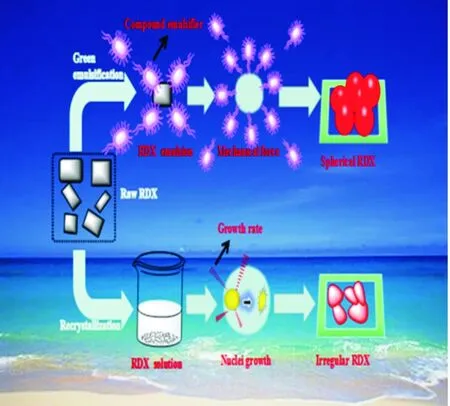
Fig. 1 Schematic diagram of refining RDX particles
The common recrystallization refinement method shown in Fig.1 mainly underwent the three stages of “stacking-nucleation-growth” of RDX nucleus. In this process, the RDX solution was sprayed into the non-solvent, and the supersaturated state acted as a driving force to cause the RDX crystal to precipitate instantaneously and start to grow. The different growth rates of RDX on a single crystal surface were the main reasons of irregular RDX crystal morphology. While the green mechanical demulsification technology mainly experienced three phases of “emulsification-mechanical demulsification forming”. Under the wetting action of the emulsifier, the entire refinement process, completed in a temperature-controlled cooling equipment, relied on strong fluid shear stress and severe high-frequency mechanical effects to complete the demulsification refinement. And the whole operation was not doped with organic solvents, achieving a safe and green purpose.
For more concise distinguish, the RDX particles prepared by the green mechanical demulsification technology and the recrystallization method[9]were labeled as RDX-1 and RDX-2, respectively.
1.3 Characterization
Field-emission scanning electron microscopy (FESEM) images were taken on a MIRA3 LMH SEM (Tescan) at 10kV. X-ray diffraction (XRD) patterns were obtained using a DX-2700 (Dandong Haoyuan Corporation) X-ray diffractometer with Cu-Kα(40kV, 30mA) radiation atλ=1.5418Å. All samples were scanned from 5° to 50° with steps 0.03 and 6s counting time.
Thermal analysis was performed on a differential scanning calorimeter (DSC-131, France Setaram Corporation) at heating rates of 5, 10 and 20℃/min.
The impact sensitivity was tested with a homebuilt type 12 drop hammer apparatus. The special height (H50) represents the height from which (2.500 ± 0.002)kg drop-hammer will result in an explosive event in 50% of the trials. In each determination, 25 drop tests were made to calculate theH50.
The particle size was tested by QICPIC dynamic particle analyzer (SYMPATEC Co., Ltd.), and its working environment was 5—35℃, relative humidity was less than 85%, light source type was He-Ne laser, power was 2.0mW , and wavelength was 0.6328μm.
The friction sensitivity was measured by a pendulum friction meter according to the GJB772A-97 standard, and the test conditions were a swing angle of 90°, a drop height of 25cm, and a dose of 20mg. Whether an explosion had occurred was determined by means of the phenomenon such as the sound, smoke, and luminescence generated when the RDX sample to be tested was subjected to an instantaneous impact or friction. And the friction sensitivity was characterized by the percentage of explosion.
2 Results and Discussion
2.1 Morphology and particle size analysis
Fig.2 demonstrates the RDX crystal morphology before and after refinement and the crystal size distribution of RDX refined by the two methods.
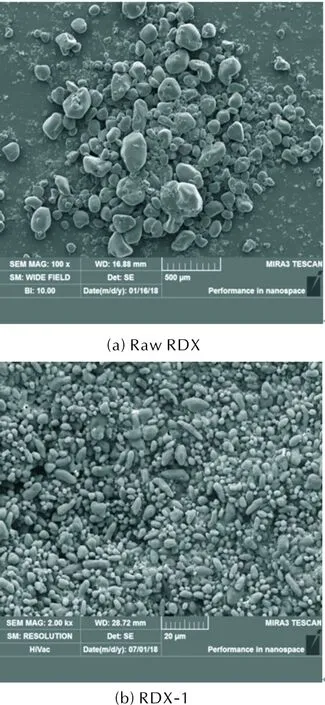
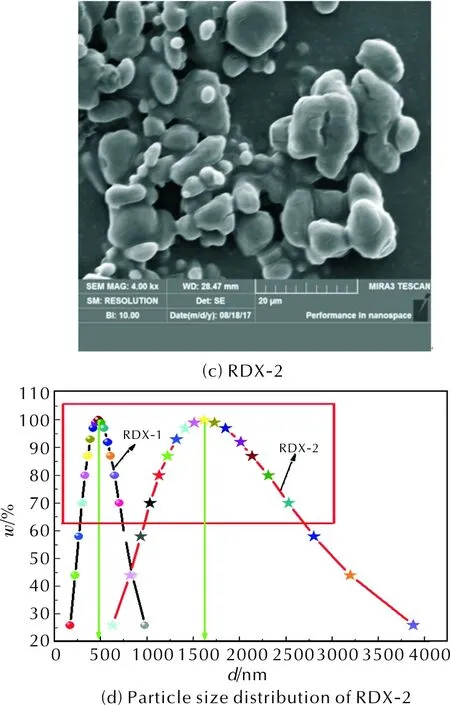
Fig.2 Morphology and particle size distribution of RDX particles
It is notable that the raw RDX has a concave surface with a large particle size distribution range, and its morphology shows obvious defects. But the morphology and particle size of the refined RDX particles have gotten much improvement. The RDX particles prepared by using the green mechanical demulsification technology (as shown by RDX-1) exhibit regular crystal morphology, smooth surface, good plumpness, and uniform particle size distribution with a median particle size of approximately 470nm. However, the morphology of the RDX particles obtained through the conventional recrystallization is improved compared with the original ones, but still irregular. And the particles are bonded to each other, the particle size distribution is inhomogeneous, and the median grain size is approximately 1600nm. In general, the refined submicron-RDX particle size distribution presents a unimodal phenomenon (as shown in Fig.2, the particle size distribution), which is consistent with the particle size in the particle size and morphology[10]. That is, RDX particle size distribution has fractal features. The particle size distribution characteristics under double logarithm are shown in Fig.3. As can be seen from Fig.3, there is a linear relationship between the weight cumulative percentage of RDX particle (Y) and the RDX particle size (x). The fractal dimensionDof the particle distribution of RDX-1 and RDX-2 was 1.54473 and 0.82996, respectively (Available fromD=3-K,Kis the slope of the line). Further fractal geometry analysis of the particle size distribution of submicron-RDX particles shows that the fractal dimension of the particle distribution of the RDX refined by recrystallization is relatively low and easily broken. The lower fractal dimension can be attributed to the serious agglomeration of ultrafine particles and the lower compactness of agglomerated particles.
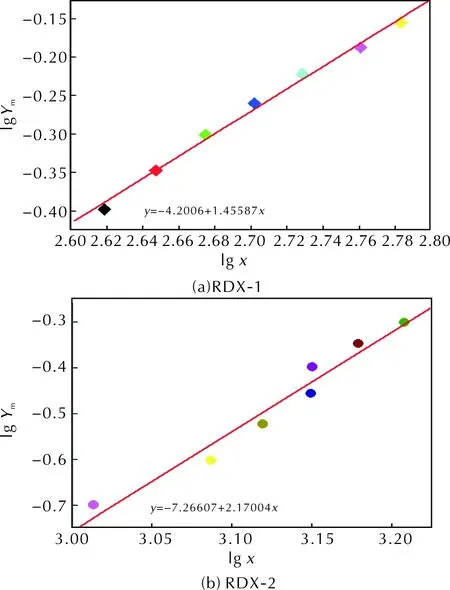
Fig.3 Characteristic graph of RDX particle size distribution
2.2 Crystal structure of RDX samples
In order to investigate whether the crystal structure of RDX was destroyed during the refinement process, XRD analysis was carried out. And X-ray diffraction of RDX samples are displayed in Fig.4.
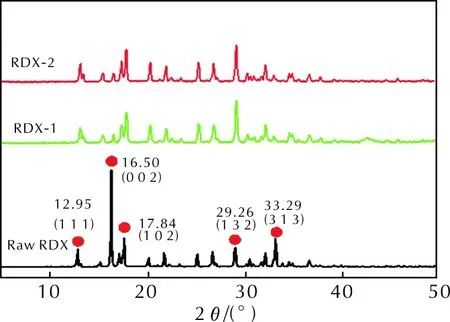
Fig.4 X-ray diffraction pattern of RDX before and after refinement
As shown in Fig.4, the X-ray diffraction peaks of RDX before and after refinement can correspond to each other one by one. Comparing the RDX PDF card (JCPDSNO.00-046-1606), the characteristic diffraction peaks at 2θof 12.95°, 16.50°, 17.84° and 33.20° in the X-ray diffraction pattern correspond to (1 1 1), (0 0 2), (1 0 2) and (3 1 3) crystal faces, respectively. It is noteworthy that the diffraction intensity of these diffraction peaks is weakened and the diffraction width is widened. This because the intensity of the diffraction peak of XRD decreases as the particle size decreases, corresponding to the previous literature[11-12]. Also, this can be explained by the Scherrer formula, the particle size of the grains is inversely proportional to the half-peak width of the diffraction peak, as shown in formula 1. It is precisely because of the ultrafine processing, the size of the RDX becomes smaller, resulting in a widening of the diffraction peak. This phenomenon also indicates that RDX crystals are submicron-sized. Surprisingly, in the X-ray diffraction pattern, the diffraction peak at 2θof 29.26° exhibits an increase in diffraction intensity, which ascribed to the preferred orientation growth of the refined RDX on the (1 3 2) crystal plane[13].
Dhkl=kλ/βcosθ
(1)
Dhklis the grain diameter perpendicular to the crystal plane (hkl),kis the scherrer constant (usually 0.89),λis the incident X-ray wavelength (wavelength is 1.5418Å),θis the Bragg diffraction angle (°), andβis the half-peak width of the diffraction peak (rad).
2.3 DSC analysis of different RDX particles
The thermal properties of RDX before and after refinement were conducted by DSC, and their activation energies were calculated, and the changes of thermal properties before and after refinement were analyzed as well. The test results are shown in Fig.5. In the fitted curve, K represents the Kissinger method, O represents the Ozawa method, and S the Starink method.
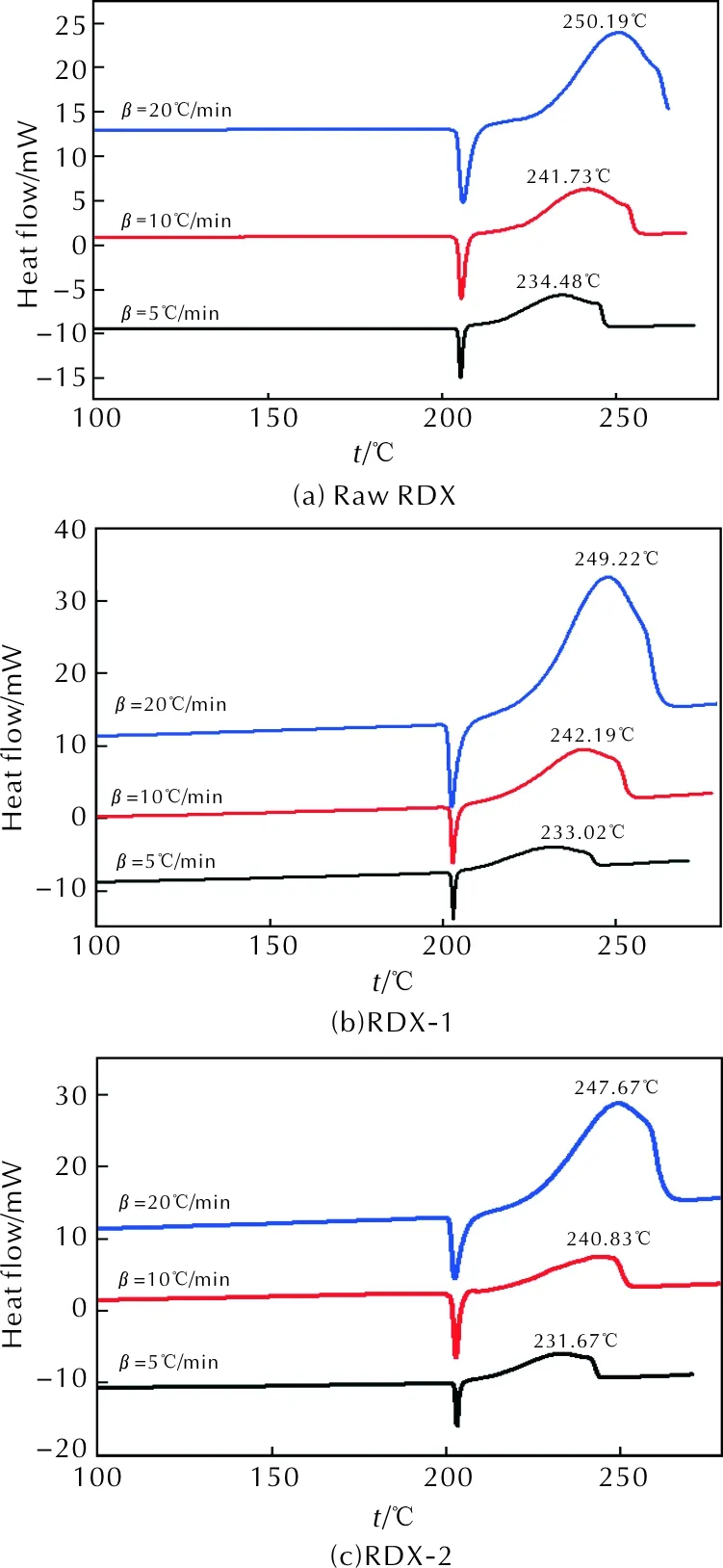
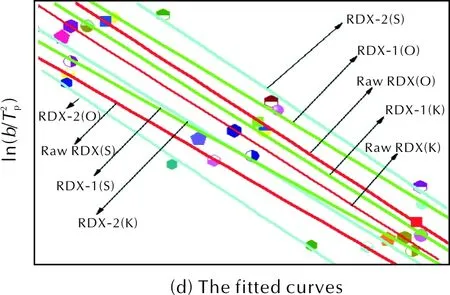
Fig.5 DSC curves and fit curves for different RDX samples
As can be seen from the above figure, all three RDX particles have similar thermal decomposition behaviors. In particular, there is a distinct endothermic peak at around 205℃, indicating that the recrystallization refinement and green mechanical demulsification technology did not affect the thermal decomposition mechanism of RDX.
Based on the decomposition peak temperature values of three different RDX samples at different heating rates, in order to ensure the accuracy of the calculation, the decomposition activation energyEaand the pre-exponential factorAof the three RDX particles were calculated by Kissinger formula, Ozawa formula and Starink formula, respectively[14-16].
(2)
(3)
(4)
In the formula (2)-(4):Tpis the decomposition peak temperature value of the explosive at the heating rateβ, K;Ris the gas constant, 8.314J/mol/K;βis the heating rate, K/min;Ais the pre-factor, min-1or s-1;Eais the apparent activation energy, kJ/mol;Csis a constant.
The apparent activation energy (Ea) acquired through the Kissinger formula and the peak temperature (Tp0) obtained when the heating rateβtends to zero by the formula (5) were brought into the formula (6) to figure out the thermal explosion critical temperatureTb[17].
(5)
(6)
The calculation results are listed in Table 1.

Table 1 Thermal decomposition kinetic parameters of different RDX samples
Table 1 shows that theEaof the refined RDX-1 and RDX-2 decreased from 189.23kJ/mol to 163.27kJ/mol and 182.39kJ/mol, respectively, compared with the raw RDX. Especially theEaof submicron-sized RDX fabricated via green mechanical demulsification technology was reduced by 25.96kJ/mol. On the one hand, this is related to the strong surface effect and quantum size effect after the reduction of particle size. On the other hand, as the particle size of RDX becomes smaller, the surface area gets larger, so that the external energy absorbed over a period of time increases. And the heating surface and the reactivity are correspondingly improved, making theEaof the refined RDX significantly weaker than that of the raw RDX, which is consistent with the results in literatures[18-19]. Interestingly, the thermal stability of the refined RDX was markedly reduced, and theTbof RDX-1 and RDX-2 decreased from 227.53℃ to 223.39 ℃ and 220.95 ℃, respectively. This is for the same quality RDX, the smaller the particle size is, the larger the surface area will be. At a certain heating rate, the external energy absorbed by the particles increases over a period of time, and the heating area and the reactivity are also enhanced, leading to an advance in theTbtemperature. However, the RDX particles refined by the conventional recrystallization showed worse stability, which is caused to a large amount of agglomeration.
2.4 Safety performance
According to the experimental method of the national military standard GJB772A-97, the impact sensitivity and friction sensitivity of the RDX particles before and after refinement were tested.
It can be seen that the impact sensitivity and friction sensitivity of the refined RDX particles are reduced in various degree as comparison with the raw RDX. Among them, theH50of RDX-1 is increased from 24.34cm to 45.78cm, and the friction sensitivity is reduced from 100% to 86%; while theH50of RDX-2 is increased to 33.21cm, and its friction sensitivity is only reduced to 94%. This phenomenon is closely related to the particle size distribution and morphology of RDX particles. According to the hot spot theory, RDX particles with narrow particle size distribution can increase the heat transfer rate between particles when exposed to external stimuli, and it is not easy to cause hot spot aggregation in a short time. In addition, the more obvious the spheroidization effect is, the larger the dispersion surface area and the gap between the particles will be, efficiently slowing down the stress concentration of the RDX when it is suffered from the external stimuli[20-21]. Therefore, RDX-1 has better impact sensitivity and friction sensitivity than RDX-2.
3 Conclusions
(1) The submicron-RDX particles obtained by green mechanical demulsification technology tended to be spherical, with a median diameter of 470nm and uniform particle size distribution.
(2) TheH50of the resultant particles increased from 24.34cm to 45.78cm, and the friction sensitivity decreased from 100% to 86%, remarkably improving the safety performance.
(3) In the double logarithm coordinates, the weight cumulative percentage of submicron-RDX prepared through green mechanical demulsification technique had a linear relationship with the particle size, and the fractal dimensionDof the particle distribution was 1.54473, indicating that such submicron-RDX possessed a narrow particle size distribution, good dispersion and distinct fractal structure.
